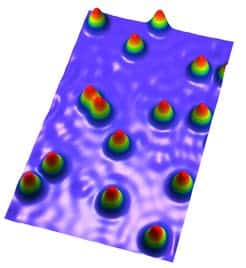There’s only so much you can cram into conventional magnetic storage devices. We’re already seeing these slowly, but surely lose ground in the face of solid-state drives, which offer more storage density and don’t have any moving parts (last longer, make no noise, etc.). What about even further ahead in the future? Well, it’s most likely that in the following couple of year or so, we might be storing information using individual atoms allowing for denser computer storage devices as well as offering the prerequisite foundation for constructing quantum computers – the computers of the future, many fold faster than computers today.
It is with this atomic scale storage concept that a team of German scientists have been dabbling with for some time now, given its incredible potential for accelerating computing in the future. The team – including researchers from Karlsruhe Institute of Technology (KIT), the Max Planck Institute of Microstructure Physics in Halle and the University of Leipzig – reports it has successfully fixed an individual holmium atom to a thin platinum surface, such that the spin of an individual holmium electron remains stable for as long as 10 minutes. That may not seem like long, I mean who wants to store data that can only last for 10 minutes, but considering this is an improvement of around one billion in time stability than in normal conditions, it gets impressive.
For one magnetic bit – binary information that can be either a one or a zero – a network of several hundred million atoms is required to keep that bit stable enough for it to be retrieved years at a time. Storing the same bit in a single atom, you can imagine, is no easy task.
Smallest magnetic storage in the world

The spin of an electron is simply the direction of rotation of that electron. Of course any rotation creates a moment – a magnetic moment in our case – which can align itself in a particular direction in an external magnetic field. One individual atom fixed to a substrate is usually so sensitive that it keeps its magnetic orientation for mere fractions of a microsecond (200 nanoseconds), but the set-up devised by the German researchers is stable for several minutes a time.
This is thanks to a great combination of physical material characteristics and environmental conditions. For one, the rare earth element holmium and the precious noble metal platinum form a quantum system whose symmetry properties keep each atom’s individual electrons from interfering with each other, which is basically the cause of electron spin destabilization. But this only happens at low temperatures. The researchers cooled the holmium and platinum substrate to near absolute zero temperature (around minus 272 degrees Celsius).
This was actually ideal, since this also offered them observational capabilities. Using an adjusted scanning tunnelling microscope, whose tip directly cools underlying atoms to near absolute zero temperature, the atoms below had their vibrations reduced to a particularly low level, allowing for long measuring times.
Alright, the next obvious step is making electron spin for bits nested on individual atoms preserve their state for as long as possible, but what about writing information? The researchers suggest that using an external magnetic field it is possible to align the spin of the holmium and thus to write information. If this attempt, in turn, is successful then they would lay down the foundations for the quantum computing age of tomorrow.
Findings were reported in the journal Nature.


